I should like to propose William Cowper as the patron saint of lockdown. Towards the end of the 18th century this reclusive poet, who was subject to periods of depression, enacted his own proto-lockdown at his home in Olney in Buckinghamshire, refusing every invitation and profoundly disinclined to venture further afield. When in 1792 he agreed to stay with fellow poet William Hayley near Chichester it was nothing less than astounding; sadly, though, the change of environment only confirmed his worst suspicions. He found the unfamiliar Sussex scenery oppressive with its ‘wild hills that aspire to be mountains, cover’d with vast unfrequented woods’; it was, he concluded, ‘too gloomy for me’. Cowper preferred his local landscape where he walked most days, trudging along muddy paths, pausing to listen to birdsong and getting to know individual trees. It may not have been spectacular but he knew it in every detail and went out in all weathers and seasons. ‘Scenes must be beautiful,’ he writes in his poem The Task, ‘which daily view’d, / Please daily, and whose novelty survives / Long knowledge and the scrutiny of years’ – lines that have become something of a mantra for me as I take my usual turn around local footpaths.
Who was Cowper’s closest equivalent in the visual arts? John Constable, perhaps, with his deep emotional attachment to the landscapes around East Bergholt in Suffolk where he had grown up, and his habit of repeatedly drawing and painting the places he lived or frequently visited – Hampstead, Brighton, Salisbury. ‘I should paint my own places best,’ he wrote to a friend, adding ‘ – Painting is but another word for feeling.’ Not for him Turner’s frequent foreign tours in search of spectacle (although Constable’s movements would have seemed to Cowper like a giddy round). Or perhaps Cowper has something in common with the young Samuel Palmer, who for several years drew upon a fund of inspiration he found in the fields and lanes around the small village of Shoreham in Kent – a place that had, for him, an atmosphere so honeyed that he called it his ‘valley of vision’.
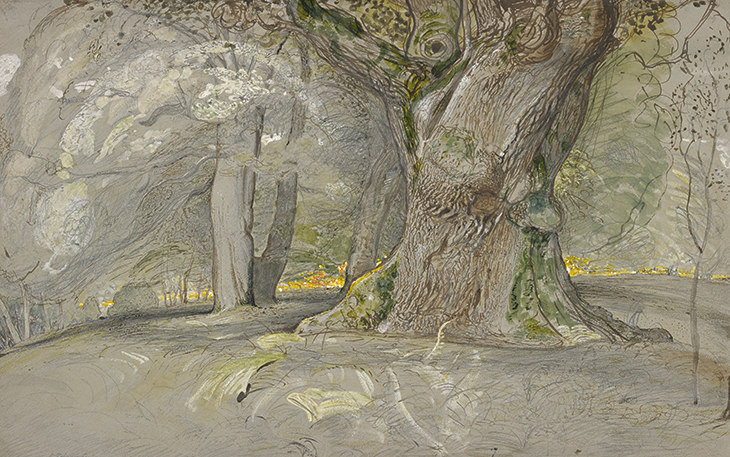
Oak Tree and Beech, Lullingstone Park (c. 1828), Samuel Palmer. Morgan Library & Museum, New York
For these artists, hand-in-hand with honouring a sense of place went a new concern with detail. Constable looked hard at hedgerows, at the fall of sunlight on a sandy bank and at foliage blowing in the breeze, the pale undersides of leaves flipped up against the sky – his art, he once drily observed, ‘is to be found under every hedge and in every lane, and therefore nobody thinks it worth picking up’. Place, for him, was tied up with practical knowledge. The son of a gentleman farmer, he could tell you the week of the year by the colour of ripening corn in a painting, and he was so interested in ploughs that he drew regional variations in his sketchbooks. Palmer took a different route. A boy from the southern fringes of London who had fallen deeply in love with the country, as a young man he regarded nature with an almost religious intensity of feeling; he sat in front of tree trunks with a fine-nibbed pen and painstakingly drew every rift and striation, and he stared at the moss and lichen growing on an old thatched roof, emerald green and egg-yolk yellow, until it took on a hallucinatory strangeness.
The focus on detail and the everyday introduced by the Romantics would shape Victorian landscapes. What changed radically was the vantage-point. Previously, painters had taken us uphill to show us the landscape: think of the grand vistas offered by Richard Wilson or John Robert Cozens. J.M.W. Turner provided imaginary theatre seats in mid-air for his most spectacular views. Look at Rain, Steam, and Speed – the Great Western Railway (1844) and ask yourself where exactly we are meant to be standing. In just a few years, however, the horizon disappeared, and the focal point crept closer and closer. Artists began to be transfixed by the ground near their feet. We find ourselves, as often as not, down on our knees with our noses grazing the undergrowth.
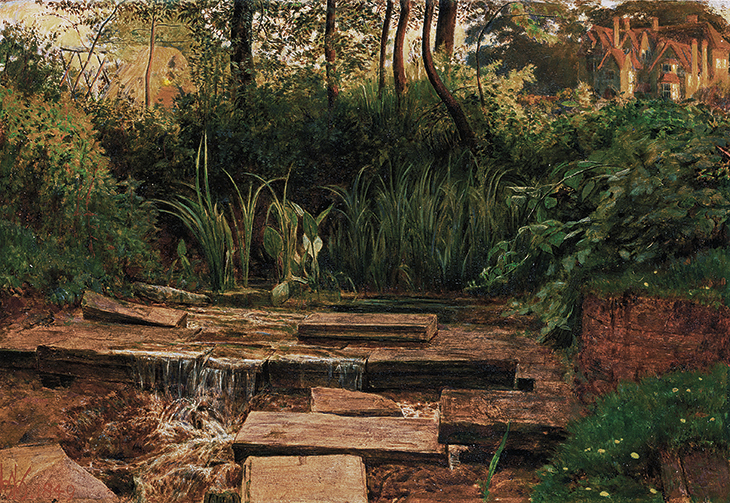
The Haunted Manor (1849), William Holman Hunt. Tate collection. Photo: © Tate
Take a landscape of 1849 by William Holman Hunt, a member of the newly founded Pre-Raphaelite Brotherhood. Its title is The Haunted Manor, but Hunt may well have added the house in the top right-hand corner later. What fills the canvas is a close-up landscape that he painted in the open air, probably in Wimbledon Park: the foreground is filled by the stony bed of a stream, and luxuriant foliage conceals much of the wider scene we imagine lies beyond. We seem to be crouching on a boulder in the stream itself, in the path of the splashing water. Our instinct is to stand up in an effort to see further – what are we doing down there anyway? Are we hiding? A high vantage point makes us lords of all we survey. Not for nothing was there a fashion for bird’s-eye views of great estates at the end of the 17th century; these high-octane paintings were statements of ownership, loud and clear. A low one makes us feel the grandeur and wildness of nature. By putting us down in the undergrowth, Hunt gives us the impression that the manor’s owner might just set the dogs on us. But the truth is that we no longer matter very much; nature has taken precedence. The forms, structures and colours of each meticulously painted leaf and wet stone have assumed a far greater importance. And perhaps getting our feet wet is a small price to pay for having such natural riches revealed to us.
The Pre-Raphaelites’ new close-up framing of landscape, from the scrubby willow and tumbling field-roses of Millais’ Ophelia to the brambly tangle in the foreground of Hunt’s Our English Coasts, 1852, chimed with the times. Yes, they were inspired by John Ruskin’s exhortation, communicated in Modern Painters, to ‘go to Nature in all singleness of heart, and walk with her laboriously and trustingly, having no other thoughts but how best to penetrate her meaning, and remember her instruction; rejecting nothing, selecting nothing, and scorning nothing’. His exhilarating words impelled these young painters to lug their equipment outdoors and scrutinise the landscape so closely that a small patch of ground filled an entire canvas. But there was a wider cultural context too. At this time natural history was a popular pursuit, and it encouraged the study of nature at close quarters. Amateur naturalists up and down the land were busy collecting specimens, pasting seaweeds on to album pages and arranging minerals and beetles in display cases. Even the Wardian cases that allowed delicate ferns to flourish in Victorian drawing rooms were like gardens in miniature, inviting owners to peer closely into the shady clearings of these doll-worlds, mysterious behind glass.
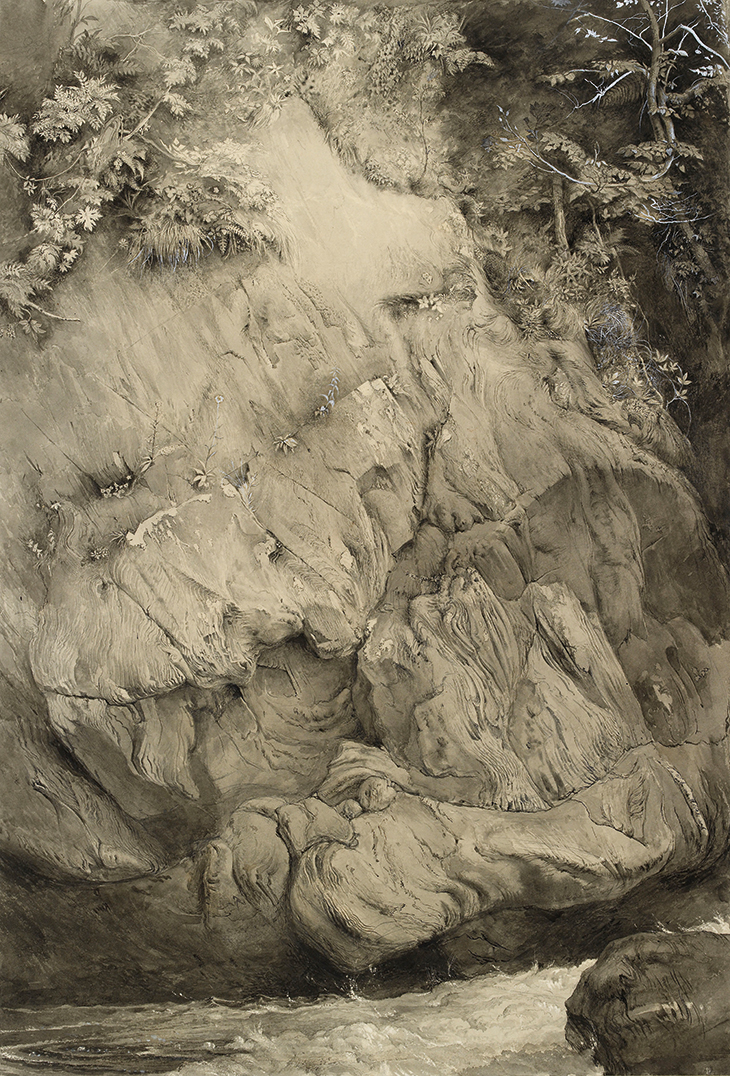
Study of Gneiss Rock, Glenfinlas (1853–54), John Ruskin. Ashmolean Museum, Oxford Photo: © University of Oxford – Ashmolean Museum
Scale was a factor in this new concern with detail, and its stability could no longer be taken for granted. When Ruskin sat down to draw a stone, he saw ‘a mountain in miniature’. He collapsed distinctions in scale by the simple means of paying close attention to minutiae: in his eyes, grains of crystal became crags. Ruskin himself produced some of the most disconcerting landscape drawings of all. Because he rarely troubled to finish them, there is often little context with which to orientate ourselves, and as a result one can badly misinterpret them. What we take to be the mossy cleft in a rock can turn out to be a forested mountainside. As viewers, we seem to shrink and grow as unpredictably as Lewis Carroll’s Alice.
Ruskin travelled widely, yet he was fixated on the local, the particular. When captivated by the atmosphere of a place he would draw it from all angles in an effort to understand it. There were times, however, when his absorption in a fragment of the landscape took on an almost pathological dimension. Witness the summer of 1853 when Ruskin was on holiday at Brig o’Turk in the Trossachs with his wife Effie and John Everett Millais. Millais was on a riverbank, slowly, painstakingly painting the background to a portrait of Ruskin. A little further along – within instruction-shouting distance of his young protégé – Ruskin was drawing a section of gneiss rock on the opposite bank. For two months he stared at the bumps and wrinkles of his rock, working obsessively, getting it all down on paper. He was in awe of the information held by this tightly focused landscape, by what its folds and fissures told him about its formation. While he was doing this, Effie and Millais were paying ever closer attention to each other. If conservators ever contrive a device for testing paper and pigments for suppressed emotion, I bet this drawing would register at the top of the scale.
While Ruskin loved detail, he could be dismissive of quotidian aspects of the local. He disapproved of Ford Madox Brown’s An English Autumn Afternoon (1852–55) because of its view over suburban gardens, and asked him why he had chosen ‘such a very ugly subject’. ‘Because it lay out of a back window,’ was Brown’s simple reply. Or to put it another way, he didn’t choose it at all – it was simply there, like the views through our own windows that have, for many of us, lately become more familiar than ever. And for all its busyness, there is a calm and principled air to Brown’s picture. Cowper would have understood.
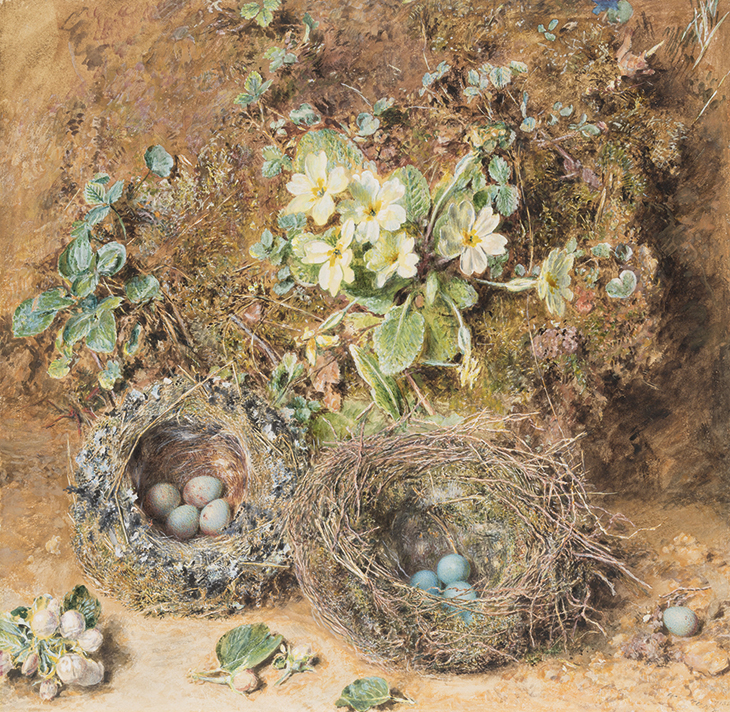
Primroses and Bird’s Nests (1850), William Henry Hunt. Victoria and Albert Museum, London
Artists had other reasons for framing the landscape narrowly. William Henry Hunt was born with a condition affecting his legs that made it difficult for him to walk, so roaming far and wide in search of viewpoints was not an option open to him. Eventually he got round the problem by shrinking the landscape to natural materials he could find near at hand. Back in the 18th century Gainsborough had amused himself by making his own table-top landscapes of rocks (coal), trees (broccoli) and lakes (mirror-glass), but he did this to tickle his imagination into envisaging wide landscapes. When Hunt gathered moss, primroses, birds’ nests and nuts, it was to create a new kind of landscape-in-miniature. We find ourselves absorbed by Hunt’s minute, pointillist detail; the pleasure we used to derive from a sweeping vista is replaced by our wonder at the bloom of a bird’s egg and an earthy bank shaggy with moss. Ruskin championed Hunt, and no wonder. If a crystal could be a crag, then Hunt’s miniature landscapes represented the wider world on a profound and symbolic level.
There were also landscapes of the mind, and these could take us even further into the undergrowth. While Richard Dadd was incarcerated in Bethlem Hospital, this fairy-painter slowly created his most famous work, The Fairy Feller’s Master-Stroke (1855–64). Separated from the natural world, Dadd turned his thoughts inwards and downwards, imagining what he might see if he were to lower his face to the level of the turf, take a magnifying glass and squint through the tall grass stalks and past the daisies. What he found there was an unfolding fairy drama. There are fantastic distortions of scale: a tiny section of mossy ground is used as though it were a forest clearing; a gigantic chestnut is about to be split in two – to form a carriage for Queen Mab, as Dadd later explained in a note. A dragonfly hovers; in proportion to the figures, it is the size of a pterodactyl.
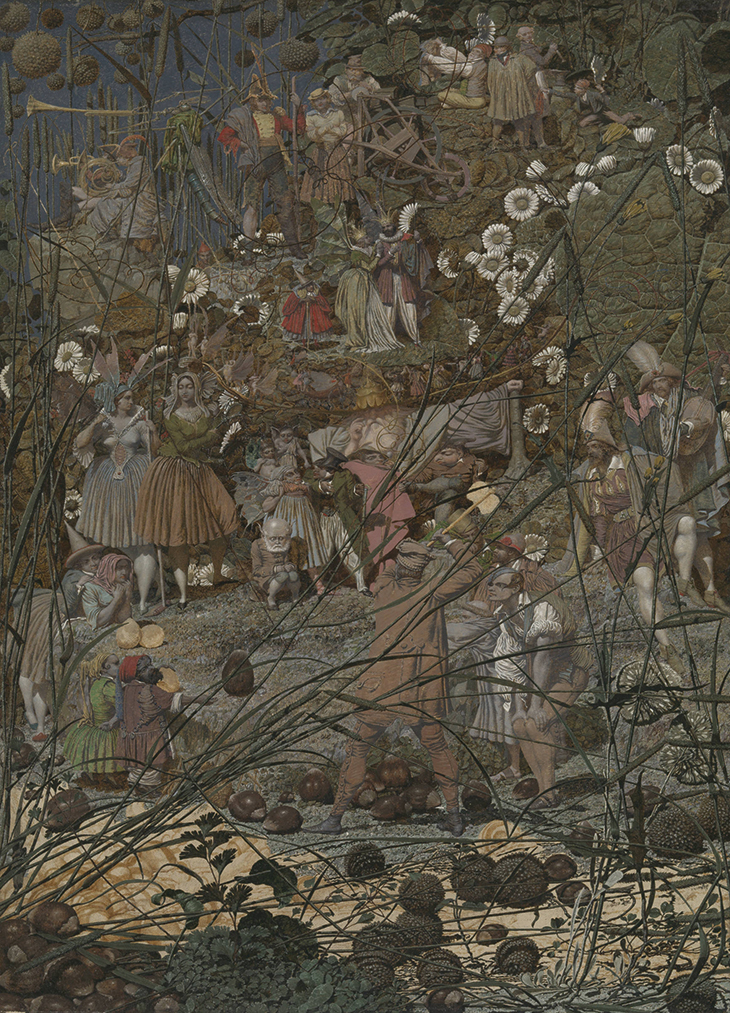
The Fairy Feller’s Master-Stroke (1855–64), Richard Dadd. Tate collection. Photo: © Tate
I find The Fairy Feller a difficult painting to look at. My eye does not move easily from one figure or group to the next; at each point it seems to get snagged on a stalk or a seed case and to need a shove. This may be an involuntary reaction to its strange, disrupted perspective. Or perhaps I am making excuses – it may simply be that I am afraid of these enigmatic fairies. Scale, as Ruskin was demonstrating, cannot always be trusted. Dadd’s landscape-drama, oppressive with detail and bristling with its own inscrutable codes, seems poised to trap us inside if we linger too long, leaving us bewitched and forever blundering about among the tangled stems.
*
As ideas concerning the actual age of the earth and the geological processes that had shaped it came to be understood and accepted, landscape painting assumed a greater significance and seriousness than ever before. The land – especially rocks – exerted a new fascination and posed urgent problems. One of the new theories to digest, developed by Charles Lyell in his influential Principles of Geology (1830–33), was that the natural forces that made the earth look as it did were ongoing, as inevitable and unstoppable as the tide. People no longer felt they were standing on stable ground, and they were quite right. These anxieties are expressed in every sharply defined rock and crumbling cliff-face of William Dyce’s Pegwell Bay, Kent – a Recollection of October 5th, 1858 (c. 1858–60). It is, on the face of it, a gently anecdotal landscape scene: in the raking, late afternoon light a family is preparing to leave the beach. Two women huddled in shawls gaze intently at the sands by their feet, one bending almost double to reach for something – shell, pebble, fossil? – that lies there. At the far right-hand side, a man throws back his head to gaze in the opposite direction where, faint against the washed-out blue, a comet makes its slow progress through another part of the universe. There is something slyly pantomimic about the exaggerated postures of these two figures as they enact looking: one at the close-at-hand and the other at the far distant. Down here is the local, and up there is the universe.
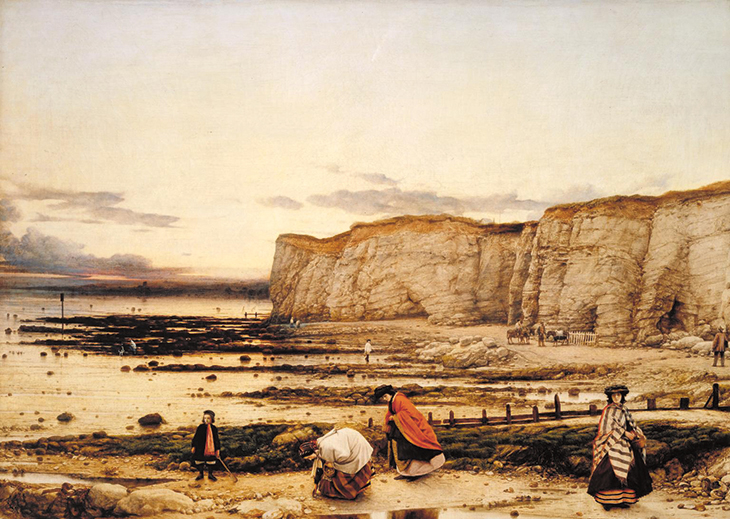
Pegwell Bay, Kent – a Recollection of October 5th 1858 (c. 1858–60), William Dyce. Tate collection. Photo: © Tate
But wait: it isn’t as simple as that. Stones and pebbles on a beach can be admired – they can even be put in your pocket and taken home – but even these humble fragments bear witness to the fact that Earth is far older than had previously been supposed. Pegwell Bay gives detail a cosmic dimension. Like Ruskin seeing a mountain in a stone, Dyce uses the particular and the local – one day, in a certain place – to meditate on deep history and unimaginable distance. The comet will keep moving, the painting seems to say, and the cliffs eroding; the great geological forces that formed the earth keep rolling on. For all its shawl-wrapped cosiness and wistful, end-of-season melancholy, Pegwell Bay is one of the most disquieting pictures of its era.
From the January 2021 issue of Apollo. Preview and subscribe here.
Unlimited access from just $16 every 3 months
Subscribe to get unlimited and exclusive access to the top art stories, interviews and exhibition reviews.


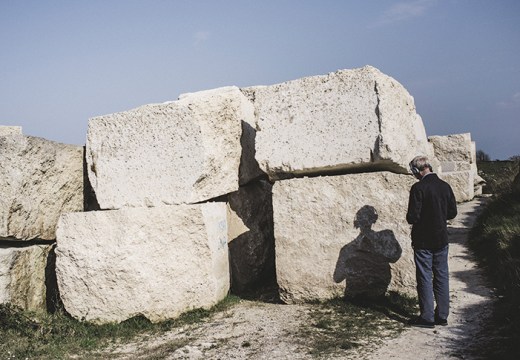
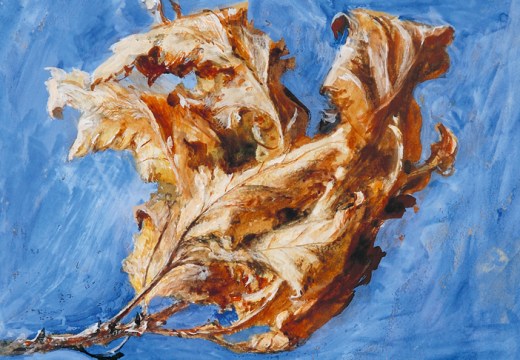










![Masterpiece [Re]discovery 2022. Photo: Ben Fisher Photography, courtesy of Masterpiece London](http://www.apollo-magazine.com/wp-content/uploads/2022/07/MPL2022_4263.jpg)
It’s time for the government of London to return to its rightful home